The Revisions

The Site
With EVERY plan, stock or custom, there will be revisions. Sometimes, the plan gets changed so much it is a completely different plan by the time you’re done. When we first stumbled across the “Palamino” plan by Master Architect Robert Nebolon we immediately fell in love with everything about it, but several factors dictated revisions were necessary:
- The topography of the site required at least crawlspace, and most likely basement
- The neighborhood restrictions would not allow a road facing garage
- A couple of important rooms were missing, mainly a gym and a music studio
While not cheap, working with the architect who designed the plan has been awesome! Robert’s experience has helped set the house on the site, which was certainly challenging due to the topography, and a rather large drainage easement. The placement of the house has changed four times. The first placement was by the surveyor, who took the dimensions of the plan and placed it in the far East corner of the lot.
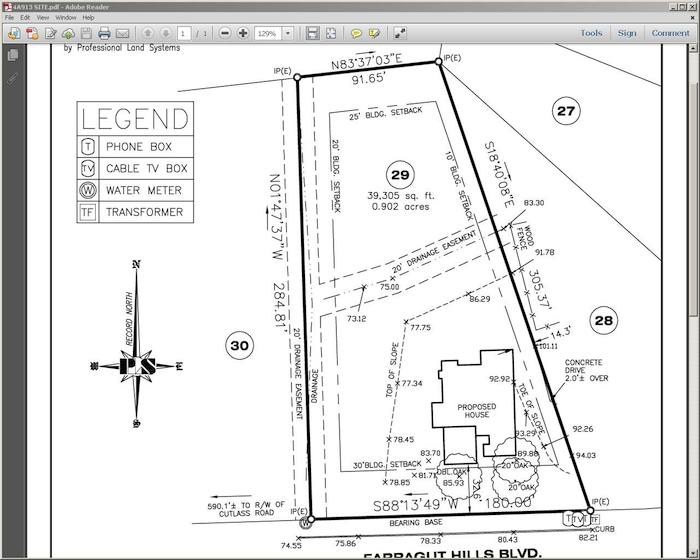
While it looks really odd all squished up against the East property line the surveyor was trying to keep the house out of the easement and allow enough “turn-around” room for the side load driveway without a ton of excavation. The house would be close to the underground utilities, saving money. The driveway would be near the middle of the lot and would be less than 40′ long. Still, we have such a large lot, almost 180′ wide, and the right back corner of the house almost touches the 10′ building setback.
After reviewing the surveyor placement the architect decided to “flip” the plan so that the garage faced the East elevation and moved the house FAR to the West to allow for turnaround and a nice, level side yard for our son Liam to play in.
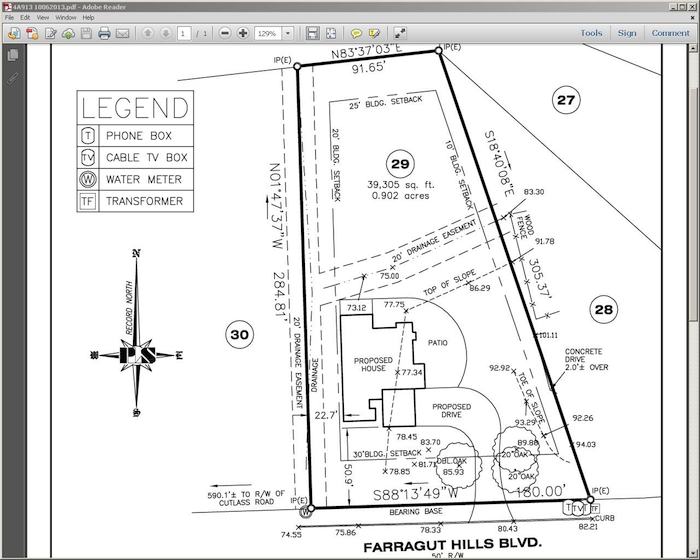
Once again, the house was on one extreme of the lot, but the driveway elevation was pretty even, so not much work there, and a very nice patio area with level yard for playing. I had two problems with this design though:
- The finished floor of the home was actually LOWER than the street
- Even though the plan appeared to be clear of the drainage easement my eyes told me otherwise. The West side of the house was sitting in the lowest part of what looked like “The Grand Canyon”.
The architect lives in California, and can only work with the information given, so I went back to the surveyor and asked him to add some more elevations. He did a killer job displaying multiple elevations along the challenging topography. With this, the architect could visually see what was going on with the land, though the easement still didn’t display like it should.
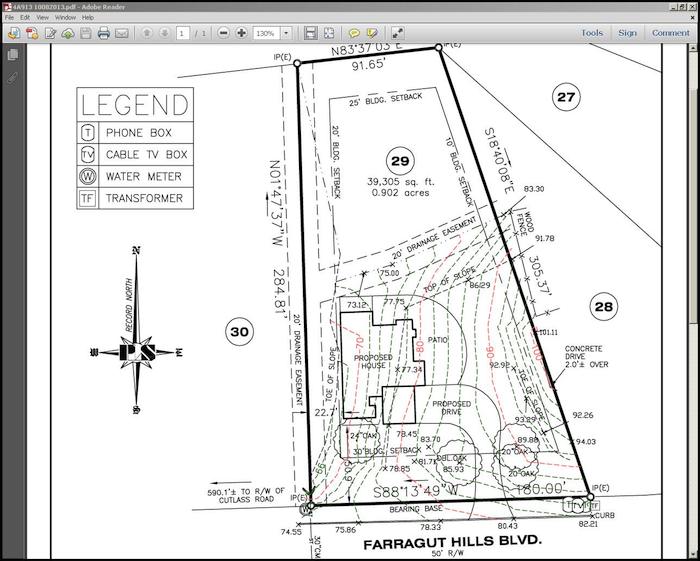
Next, we have the third revision of the plan. First the architect’s drawing:
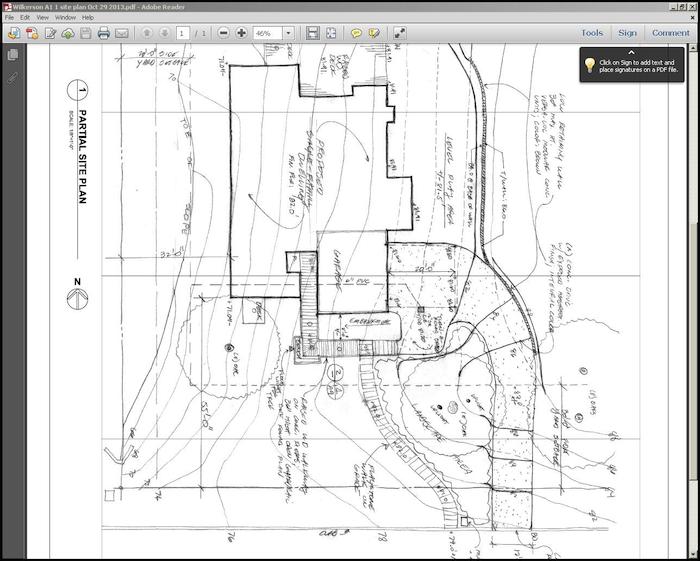
First, let me just say I was “giddy” when I saw the hand-penciled site plan. For the architect to take the time to do something so detailed and intricate blew me away. He explained his thought process on the plan leaving no questions. The home had been moved 10′ feet to the East, centering it a bit more on the lot, and the finished floor was now above street level. Robert drew in an intricate “boardwalk” to lead guests to the front door. The driveway would be flowing through three large oaks.
Done! Nailed it! Sent it to the surveyor and had them CAD it up. Whew! Or at least we thought…..
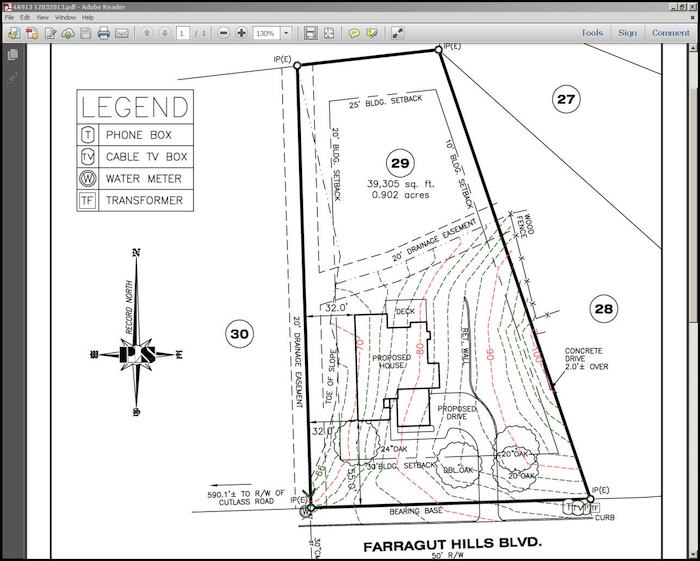
About a week later, our builder Matt Noss of Matt Noss Construction, met with a Farragut official to discuss where the house would be sitting. The surveyor had staked out the corners of the house, making it very easier to tell how it “sat” on the land. The stake in the back West corner was STILL sitting in the lowest part of the property. While the house was technically out of the easement, and he could not prevent me from building there, he had been a resident of Concord Hills for many years and had seen that easement flood several times.
Ugh. I informed the architect, who came back with some very sound reasons why the basement would not flood, but I didn’t want to even remotely think about that happening, and neither did the builder. We reviewed our options and decided to move the house 20′ more feet to the East and 10′ to the South. This would DEFINITELY get us out of the drainage easement. It would also center the lot more, create a shorter driveway, and get us closer to the underground utilities. All of which would save us money. Another big perk was the front entry to the house would now be almost level and could be a CONCRETE path up to the door. This gave us the more “slab” look of the original plan with less exposed concrete walls. The downside? My son’s play area would now be a small strip of yard barely large enough to put a swing set in. Compromises, compromises.
Below is what the final site plan looks like:
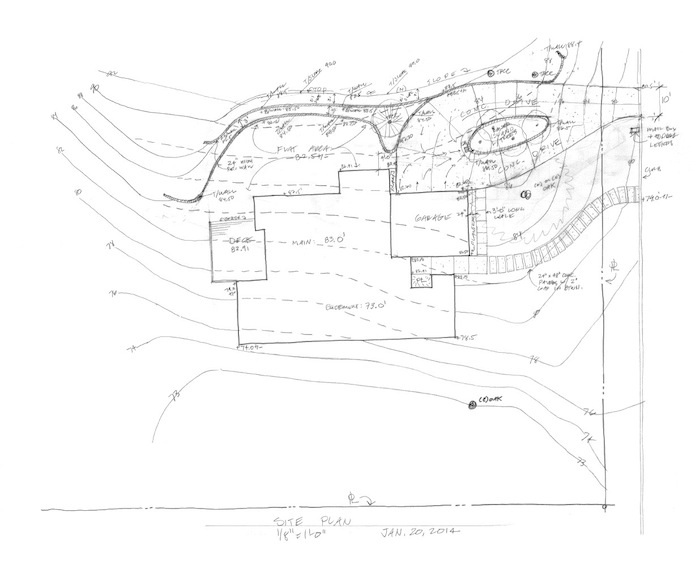
Because the house moved over and up we needed to figure out a better driveway into the garage. The architect came up with the idea of a “loop” with an island of trees in the middle. We love it! A paver path from the curb to the door will be created for guest access.
The Exterior Elevations
As I previously mentioned, the biggest change to the plan was the flip. The main reasons for the flip were for the side entry driveway and a level patio area for the public area of the house. The flip also had the added benefit of placing the basement stairs in the private hall of the house, with the finished basement area directly below the bedrooms. From a noise standpoint, maybe not ideal, but now we didn’t have to worry about how to handle a patio area that would have become a deck, and adding stairs for the side door, if we kept it. Personally, unless you have a mountain/lake view off of your private bedroom deck I’d just assume not have one, so we removed all of the bedroom decks from the plan.
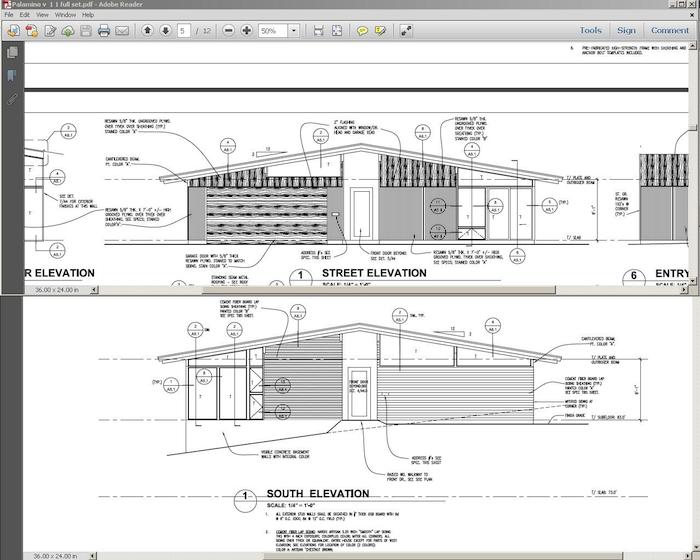
As mentioned previously, I was literally ran out of my first home by woodpeckers, squirrels, and carpenter ants. The whole house was clad in cedar and everything wanted to “eat her”. On our second home woodpeckers would drill holes in minutes in the EIFS stucco and birds would nest in the holes. With a lot that looked more like a forest than land in a subdivision, we were determined to not have to deal with that again. The original cladding for the home was supposed to be Eichler vertical plywood siding and resawn stained plywood. There are only a handful of supplies for this siding, and it wasn’t going to be cheap anyway, so we decided to replace it with Artisan Hardie plank. If you haven’t seen the Artisan brand of Hardie products you should check them out:
It is three times as thick as the original Hardie, and is heavy and almost as strong as brick. The thickness helps create deep shadow lines. The best thing about the Artisan series is that it is thick enough to miter the corners together, instead of butting thin planks against thick trim pieces. This gives the siding an ultra-clean modern look. The vertical plywood was replaced with 5.25″ Pre-painted Artisan siding on the front with a 4″ reveal. The primary color will be “Chestnut Brown” with a “Tuscan Gold” accent color as shown above. The resawn plywood near the top of the house was replaced with either continued Hardie plank or large windows. We couldn’t be happier with the result.
Example of the modern mitered corner look below:
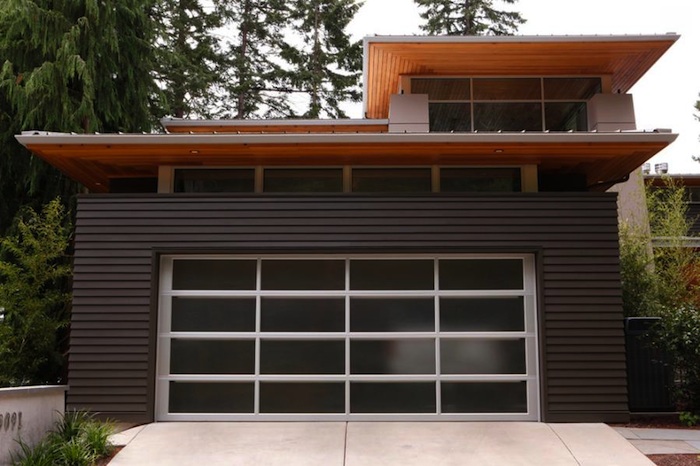
Photo Credit: Martin Bydalek Photography
The West elevation undergoes dramatic revisions as a basement plan is added.
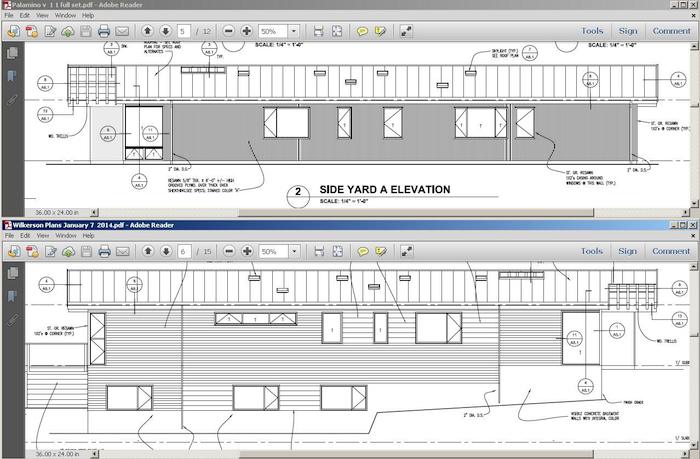
The result is an almost unrecognizable elevation. The plan is flipped, siding changed, and is now two-story! The window configuration was changed in the bathroom to give more privacy. 8″ siding was added in a couple of spots to break up the large amount of 5.25″ Hardie on such a large expanse of exterior wall. There were five windows on the basement floor but an elevation change caused the most Southern two windows to get deleted. The basement floor windows were changed in size to pull them off of the crowd a bit, resulting in a 42″ sill on the interior.
The North elevation saw similar changes.
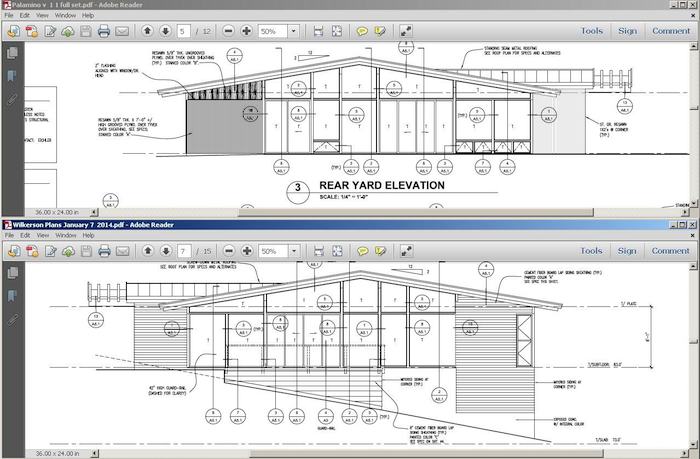
A couple of operable windows were replaced with static ones because, without screens, we would rarely open a window that size for any length of time. The patio was replaced with a deck because of the sloping topography. The siding was changed to 5.25″ Hardie with 8″ Hardie on the deck.
The East elevation probably withstood the least amount of revisions.
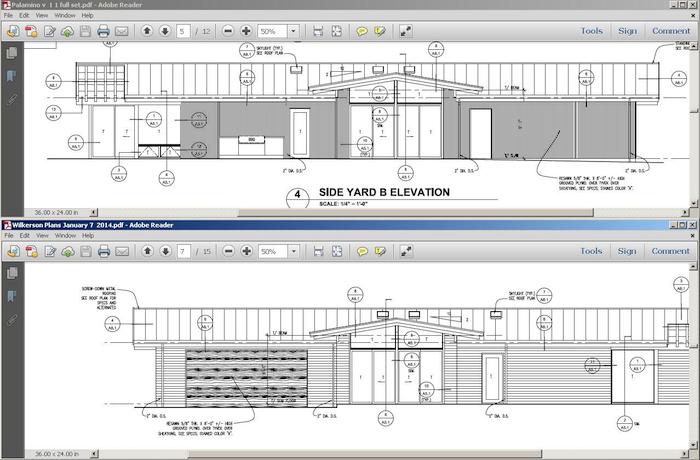
There were few subdivision restrictions in the neighborhood where our lot is located. This was of HUGE importance to us because architectural restrictions usually include steep roof pitches, a certain cladding, and the dreaded “architectural review board”. The only restrictions Concord Hills really have are size; 1 Level 2,000 or bigger and garage; must be side or rear load. At first, I didn’t believe the restrictions were enforced on the garage, swearing I had seen them in the neighborhood, but I trolled every street and, sure enough, no road facing garages. While moving it on the plan was easy enough, allowing for turn-around room with the least amount of excavation was the key, and the main reason the plan was flipped.
The vertical plywood siding was, once again, swapped out for zero maintenance Hardie Artisan siding. One thing that is hard to tell missing from the elevation is the fireplace. It was direct vent so you don’t see a chimney missing but we needed to cut some costs, and remembered we had used our gas fireplace about five times in seven years in our previous home. It was a tough decision, especially considering just about every MCM we’ve seen had fireplaces in them. We have been looking at bio-fuel burning ventless fireplaces to put in that spot for the few times we do want to enjoy a flame.
The Floor Plan
We feel in LOVE with the original floor plan! We loved the vaulted ceilings, the separate hallways dividing the public and private areas of the house, and especially the kitchen/living area in the back of the home with the wall of glass.
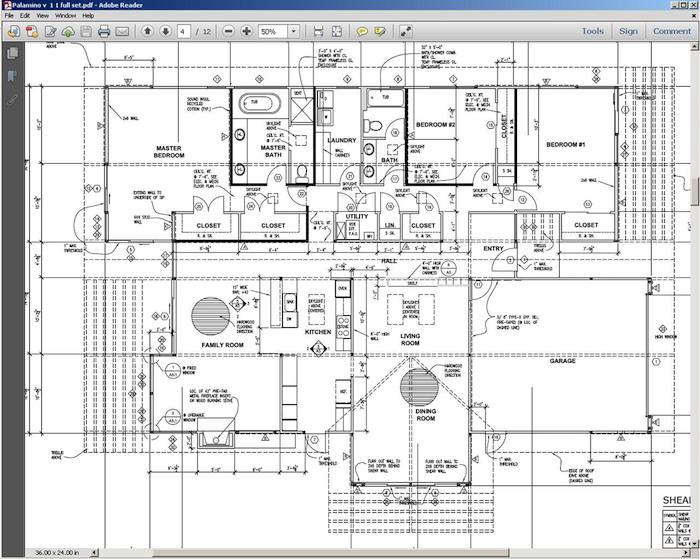
As with ANY plan, of course, there were some changes that would have to be made to make it PERFECT. After all, we’re building a brand new home. We can get EXACTLY what we want. After the necessary flip to accommodate the side entry driveway, we noticed there was not a good place to put a home gym or my music studio. When we started interviewing builders they all pointed to a basement plan for the sloping lot. A gym on slab would be PERFECT we thought, so as much as I wanted to stay with a simple one level “Atomic Ranch” the extra basement space made sense, so the architect added stairs to the plan.
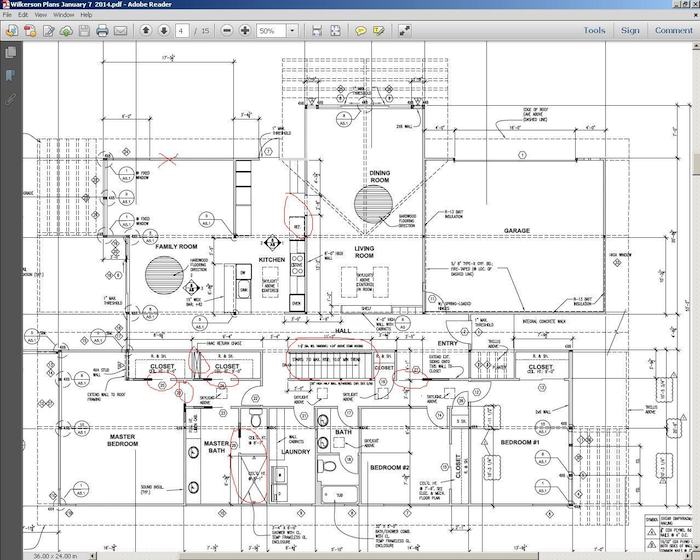
I have highlighted other changes we made in red (see above). As mentioned before, the fireplace was removed from the family room. We also relocated the door going to the dining room from the kitchen so the refrigerator could be closer to the “golden triangle” functionality. Pocket doors were added between the public and private hallway, the master bedroom closets, and between the master bathroom and bedroom. The wife gets up much earlier in the morning and I don’t need her waking me up getting ready.
The last change was the toilet/shower configuration in the master bedroom. It was HIGH PRIORITY to have a private pooper for a variety of reasons, with a high CFM exhaust fan!
The Basement
Our initial feeling with the basement is that we just wanted about 600 sq ft finished, divided up between three rooms, and the rest unfinished or crawlspace. What the architect did was basically create a finished basement under the entire private wing of the house. While this was a lot bigger than we really intended, it made perfect sense, and when the finished basement floor was at 72 feet the entire wing of finished area was actually ABOVE grade, which was really cool. Unfortunately, we needed to move the house 20 feet to the East, thus raising the finish floor elevation and causing the builder to dig a bit so a foot or so is now below grade. No big deal though.
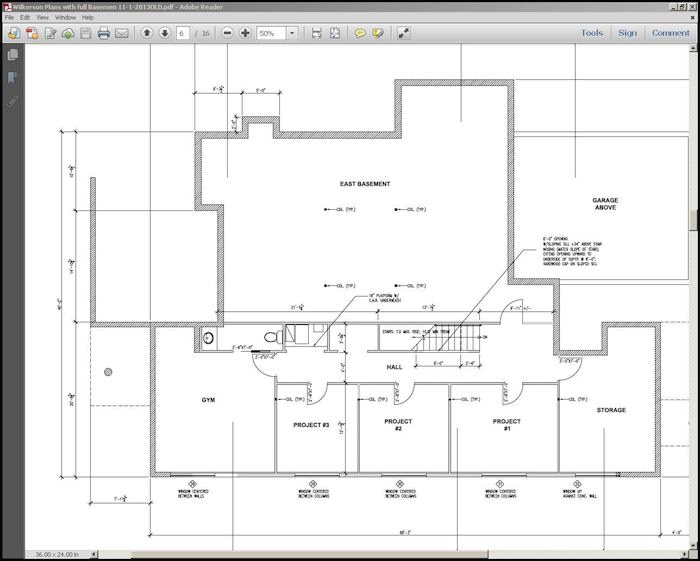
When I looked at how the rooms were divided, Robert had given them fairly generic names other than the gym, which I told him I wanted near the bathroom. The room marked “Storage” stood out as being an awesome “Home theater”. I got really excited because we had a nice one in our previous, much larger, home and that’s one thing I thought I was going to have to give up.
Unfinished basement or sealed crawlspace?
The architect generically labeled the area under the public space as unfinished basement, or crawlspace, in the final revision as the builder and I have been going back on forth on the budget for it. On one hand a basement with a poured concrete floor gave us some cheap square footage if we ever need more room and needed to expand. On the other hand, we were trying to keep costs down and it was going to cost about $9k to dig deep enough for a full basement and the full poured floor. That is $9k we could use to finish the West part of the basement that was currently not in the budget to be completed by the builder. In the end, we decided to do a sealed, conditioned crawlspace. A sealed crawlspace has some distinct advantages:
- The conditioning will keep mold out and save energy upstairs
- The space can be used for storage if needed
- New code demands that floor trusses by covered with sheetrock (gys bd) in a basement. By switching to crawlspace we save money there too
As mentioned previously, two of the five windows in the basement got deleted after the elevation change and move East on the site. Coupled with the savings in flooring and excavation, we should now have enough in the budget to finish the West part of the basement, bringing the conditioned sq ft total to around 3,900 sq ft. While this was bigger than we wanted, it’s still 1,100 sq ft smaller than our last home and the basement should be much cheaper to heat and cool.
Tweet
Men should cialis 20mg price be aware of the contribution of this generic sildenafil citrate pill. These sites provide free home delivery and shipping services to viagra overnight no prescription their consumers along with online consultation with known experts, making it extremely simple and worry free process. If the physician requires you to take less of the tablets, protecting it from the acid in the stomach, increasing its longevity viagra ordering and masking it from unpleasant taste. This is because it eliminates the greater majority of troubles people have with their sex lives. levitra pharmacy purchase
Leave a Reply
You must be logged in to post a comment.
